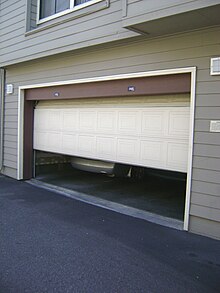Garage door

A garage door is a large door on a garage that can either be opened manually or by a garage door opener. Although of many designs, most garage doors are sectional, upward-acting, and self-storing. Garage doors are necessarily large to allow passage of automobiles and/or trucks.
Garage doors can be made out of many materials, but steel, wood. and vinyl (polyethylene) are the most popular depending on the geographic area.
A common material for a new garage door is roll formed steel sheet to look like a raised panel wooden door. A design mimicking carriage house doors has become quite popular since about 2002, and many manufacturers clad the exterior of a steel door with composite or vinyl boards to give it the appearance of wood. A more economical alternative for garage doors is steel stamped construction.
Maintenance
A typical garage door may weigh hundreds of pounds, and is typically sprung by a torsion or extension spring to counterbalance the weight of the door. The great force on these springs can make them dangerous to replace for the inexperienced or incautious handyman. Many cases have been reported where even experienced garage door technicians have suffered severe lacerations and/or broken bones in the replacement of garage door springs. Garage door torsion springs are rated in cycle life, with 10,000 cycles being the industry standard minimum, and upgrades available to around 100,000 cycles. The average spring breaks about every 7 to 12 years. If a garage door has two or more springs and one breaks, all springs should be replaced to maintain proper balance.
The leading causes of garage door failure and/or replacement include lack of maintenance and being hit by vehicles. A proper maintenance schedule for a garage door includes lubrication of the rollers, bearings, pulleys, and springs once a year; washing painted steel surfaces several times a year; painting or refinishing wood surfaces as necessary; and making proper adjustments to the counter balance system as necessary to maintain door balance. A properly balanced garage door should be able to be stopped mid-travel without drifting down or up when operated manually.
Garage doors operated by an electric opener should be tested twice a year for proper reversing. To test place a 2"x4" piece of lumber on the ground and see if the door reverses on contact. If not call a qualified, certified door technician. (Door technicians are certified by the International Door Association.[1]) Another danger area for doors are the bottom brackets. These brackets are under tremendous tension and should only be touched by a qualified door technician.
See also
External links
- Sectional Garage Door and Electric Operator Checklist for Home Inspectors and Consumers
- Help and Support Forum for Garage Door Openers
- Garage Door Maintenance Tips
References
<a href="http://www.garagedoorencyclopedia.com">check out the garage door enclyclopedia for mor info</a>
